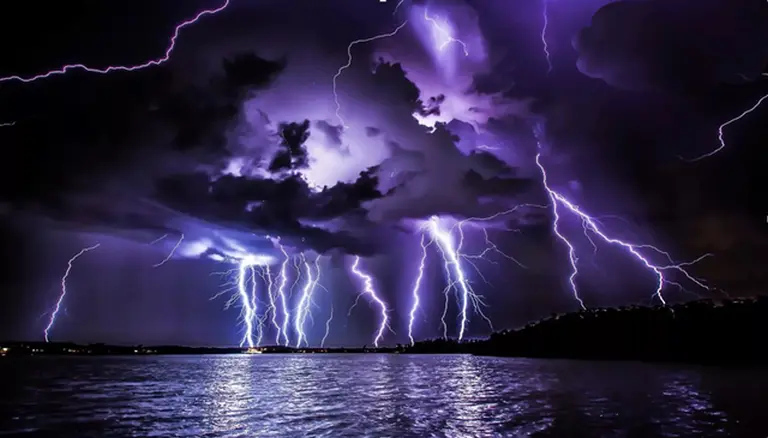Located in Zulia State in northwestern Venezuela, Lake Maracaibo is the largest lake in South America, covering an area of 13,210 square kilometers. Formed millions of years ago, this lake is not only one of the oldest in the world but also holds a unique record: it is the place with the highest lightning density on Earth. On average, the area records 233 lightning strikes per square kilometer annually, and on certain nights, thousands of strikes can be observed in succession.

Lake Maracaibo and the Catatumbo Lightning Phenomenon
The Catatumbo Lightning phenomenon, named after the Catatumbo River that flows into the lake, is a mesmerizing natural display. Lightning occurs approximately 160 nights a year, lasting 9–10 hours per night. During this time, the sky is illuminated by continuous strikes, sometimes reaching up to 40 flashes per minute. This is not just a natural wonder but a “living heritage” for the local community.

The Unique Causes of the Phenomenon
Geographic and Climatic Factors
The Catatumbo Lightning is a result of a unique combination of geography, climate, and hydrology. Lake Maracaibo is surrounded by three major mountain ranges: the Andes, Perijá, and the Cordillera de Mérida. This terrain creates a “aerodynamic corridor” ideal for thunderstorms.
Temperature and Humidity Dynamics
Warm water from the Caribbean Sea flows into Lake Maracaibo, increasing the temperature and humidity in the air. During the day, sunlight causes water vapor to rise, forming warm and humid air masses.
Colliding Air Currents
At night, these warm air masses are pushed by trade winds from the sea and collide with cold air descending from the surrounding mountains. The contrast in temperature and pressure forms cumulonimbus clouds.
Charge Formation
When water droplets in the warm air collide with ice crystals in the cold air, the process creates opposite charges, leading to electrical discharges—what we see as lightning.
Interestingly, most of the lightning here occurs within the clouds rather than striking the ground, creating a spectacular but safe light show for distant observers.

Lake Maracaibo in History and Culture
The Natural Lighthouse:
For over 1,500 years, the Catatumbo Lightning has served as a “natural lighthouse” for local fishermen. The lightning provides light to navigate their boats through the dense night, without the need for modern tools.
A Role in Venezuela’s History:
This phenomenon has also played a notable role in Venezuela’s history:
- In 1595, the Catatumbo Lightning exposed the location of Sir Francis Drake’s fleet, forcing the English sailor to abandon his plans to attack the city of Maracaibo.
- In 1823, the light from the lightning helped Venezuelan forces detect Spanish warships, contributing to a critical victory in the country’s independence struggle.
The image of Catatumbo Lightning even appears on the flag and anthem of Zulia State, symbolizing the pride of the local people in this unique natural wonder.

Scientific Insights into the Catatumbo Lightning
Scientists have spent decades studying the Catatumbo Lightning but have yet to fully explain the phenomenon. Early theories suggested that uranium deposits in the area attracted the lightning. However, modern researchers believe that the geography and air currents are the primary factors.
Dr. Daniel Cecil from the Global Weather and Hydrology Center highlights the crucial role of terrain in creating warm and cold airflows that result in thunderstorms. Meanwhile, meteorologist Grameme Anderson emphasizes the importance of the tropical climate and the mountainous surroundings of the lake in generating the world’s most intense lightning.
Environmental Impact
The Catatumbo Lightning contributes to ozone production. Although its impact is not significant enough to affect the global ozone layer, the phenomenon is still considered a positive contributor to the local ecosystem.
The lightning also produces natural electrical discharges, supplying nitrogen to the soil and enhancing the fertility of the land. This is a “gift from the heavens” that local people greatly revere.

Exploring Lake Maracaibo
Visitors to Lake Maracaibo can not only witness the “light dance” of Catatumbo Lightning but also explore the region’s diverse tropical ecosystem.
Rich Flora and Fauna
The area surrounding the lake is home to various wildlife species, including jaguars, South American anacondas, crocodiles, and countless birds. The natural scenery is a treasure trove for nature enthusiasts.
Best Time to Visit
September and October are the peak months for lightning activity, with the highest number of strikes. Visitors can observe this breathtaking phenomenon from distances of over 40 kilometers.
Unique Local Activities
Locals even use the lightning as natural “fishing lights” at night. The tranquil fishing villages illuminated by the dazzling lightning strikes create an extraordinary and rare natural landscape.

Towards a World Heritage Recognition
Recognizing its exceptional value, Guinness World Records in 2014 declared the Catatumbo Lightning the world’s most unique meteorological phenomenon. Currently, the Venezuelan government is advocating for UNESCO to recognize the lightning as a World Heritage Site, making it the first natural phenomenon to receive this title.
Lake Maracaibo is not just a natural wonder but a symbol of the harmony between humanity and nature. From the spectacular light show of the Catatumbo Lightning to its rich biodiversity and profound historical significance, this place is a dream destination for nature lovers and adventurers alike.






